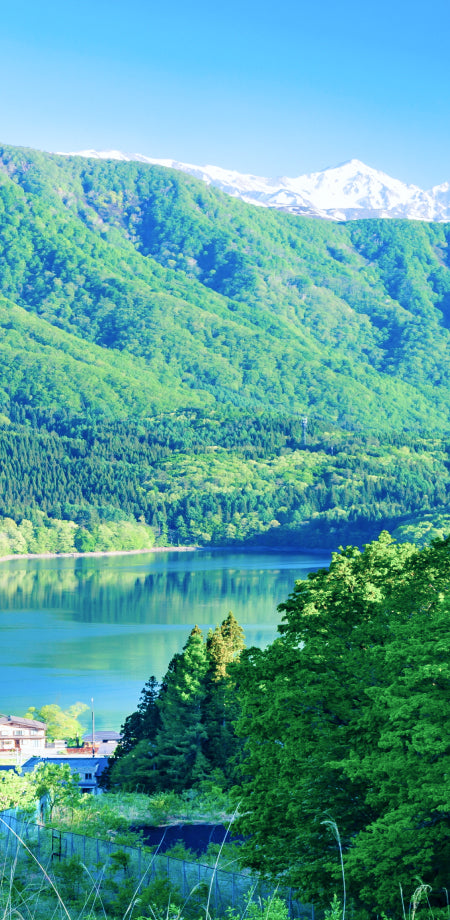投稿日:
更新日:
[Featured article] Better to overcome constraints Nagano Rice farming
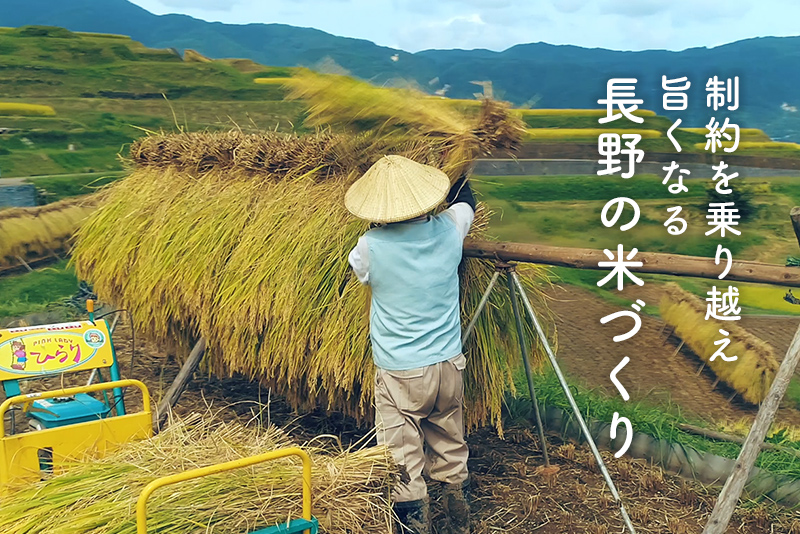
Rice has been a staple food in Japan since ancient times. Nagano While the prefecture has a wealth of water sources, rice farming is carried out under conditions that are not blessed with rice farming, with cool, rainy weather and many slopes surrounded by mountains. Even in such cases Nagano Why is the prefecture's top-class rice ratio and yield per area in the country?
There was a number of efforts by people to overcome various constraints, including ingenuity to rice fields and irrigation canals, and improvements to breeding that suit the environment.
The cultural landscape created by nature and people's efforts: "Ousu no Rice Terraces"
Kanai Minoru, Chairman of Meigetsukai
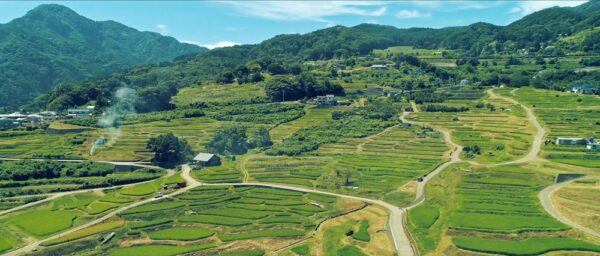
The Ose district of Chikuma City has been famous as a famous spot for Tsukimi since ancient times. Below you can see the slopes facing the Chikuma River and Zenkojidaira, and 1,500 rice terraces are spread out with about 40 hectares.
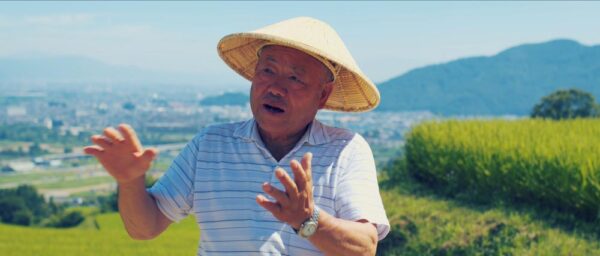
Kanai Minoru, Chairman of Meigetsukai
"The rice terraces in Oshu are strong clay-like soils with nutrient retention and water retention. This soil, which contains a lot of nutrients, nurtures a rich, delicious rice with a high flavor that is rich in amino acids. It is only natural that any other hot rice is delicious. I believe that the true value of rice is the only thing that comes to mind when it cools down, but the rice in Oshu rice terraces is sticky and delicious even when it gets cold."
This is what Kanai Minoru, chairman of the Meigetsukai, who is involved in rice terrace conservation activities.

The "Ousue no Rice Terrace" is an organically connected to the slope formed by the large-scale debris flow generated by the eruption of Mt. Mitumine, and the "Oike" upstream of the Sarashi River, a water source. There are also mentions about "Ousu no Rice Terraces" in books from the Muromachi period, but development began in earnest during the Edo period. In order to increase the collection of annual taxes under the shogunate's policy, rice fields were created not only in the plains but also in slopes of mountains with poor conditions.
In addition to fertile soil, abundant water is essential for rice farming. At the rice terraces in Osuzu, the water from the "Oike" built in the Edo period is dropped into the Sarashina River and re-inhabited the water from the Sarashina River near the rice terraces.
"The source of the Oike is water that springs from the shrine of Benzaiten, which is strange. There are no high mountains like the Northern Alps around here, but rainwater that fell on the mountains oozes through the earth.TimesAfter that, it became a very good spring, and it didn't die and it started to gush out," Kanai said.
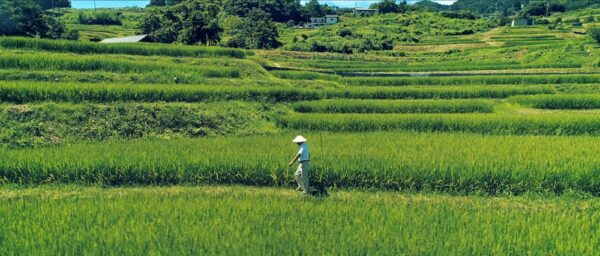
Furthermore, wisdom was required to allow water to spread across the distinctive terrain of rice terraces and allow for drainage. By inventing the drainage method using an underground culvert* made from a stone-based culvert called "Ganise" that was created in the lower layers of rice paddies, the rice terraces spread across the entire slope, creating a unique cultural landscape.
*A waterway buried underground
"We had a lot of hard work to make ends meet, and we created a system in which stones were stacked into waterways and sent water to the fields below. I often talk about it all over the place, but the rice terraces here have been built on the slopes formed by the mudslide flows, that is, the power of nature and the wisdom of our ancestors. That's why I am always grateful to nature and our ancestors. I am grateful."
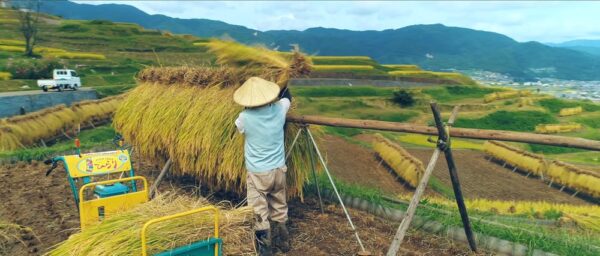
On the other hand, when it comes to rice farming in the Osu rice terraces, the aging of the people who carry it and the lack of successors are becoming a problem. The average age of the currently 13 members of the Meizukikai is about 74 years old. If no one grows rice, rice terraces will become desolate in five years. So Meigetsukai came up with the "Rice Terrace Rental System," which started in 1996. The purpose of this system is to carry over the landscape of the rice terraces into the future and deepen interactions between urban and rural areas, and members will participate in the rice planting, grass mowing, rice harvesting, and threshing events, and all harvests will belong to the members. Currently, approximately 90 members are participating, half of whom are repeat customers. Apparently, it is so popular that there are no more fields available to rent in some years.
These conservation activities have paid off, and the rice terraces in Osuzu were the first rice terraces in the country to be designated as a national scenic spot, and in 2020 it was certified as a Japanese Heritage Site certified by the Agency for Cultural Affairs.
From barren land to rice-related areas where the prefecture is competing for 1 and 2
Kurashina Takaaki, Kurashina Farm
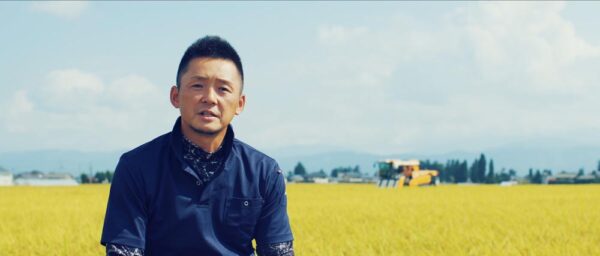
Kurashina Takaaki, Kurashina Farm
「 Nagano Even though we simply say "prefecture", the formation of the land differs completely depending on the region. Although this area is sandy and gravel, there are clay-like lands in the prefecture, and the appearance varies from region to region. Cultivation techniques that suit the characteristics of the land have been researched and developed in each region. In addition to the natural environment, I think people's ingenuity and wisdom make rice delicious in the prefecture delicious."
This is what Kurashina Takaaki from Kurashina Farm, which runs agriculture in the Azusagawa area of Matsumoto City.
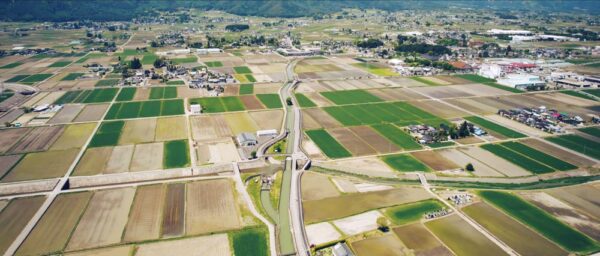
The Azusa River district of Matsumoto City is from north of the Azusa River in the Matsumoto Basin.Azumino CityorOmachi CityIt is located in the Azumino area at the foot of the Northern Alps, which extends to the vicinity. In Azumino, wasabi cultivation is popular in making use of the abundant spring water, and Azumino has the image of being abundant with water, but it is surprising that in the past, a desolate wilderness spread out due to the lack of water. The reason for this is the unique national terrain of a complex fan-shaped structure, formed by overlapping multiple rivers flowing from the Northern Alps.
"The state of Azumino differs between the upper and middle sides of the fan. The melted snow in the Northern Alps penetrates underground and gushes out at the end of the fan. Therefore, the end is rich in water so that wasabi is actively cultivated. On the other hand, the soil is mainly made up of sand and gravel layers of river sediments, so the water penetrates deep underground, making it difficult to see the surface. The Azusa River area is truly an area with no water on the surface of the midside," says Kurashina.
Azumino has a treasure trove of water called the Northern Alps, but there is no water on the surface. Therefore, efforts have been made to secure water, and over the years the waterways have been spreading like capillaries. It is common for a vertical weir to create a vertically flowing channel directly from a river called a vertical weir, but the horizontal weir, where the waterway runs almost parallel to the contour line, is the characteristic of Azumino. While transverse weirs can transport water to a wide area and hydrate the land, they also needed to interpret complex topography and draw waterways at slight slopes along contours, and extremely high surveying and construction techniques were required for cutting.

In Azumino, six horizontal weirs were opened, starting with the Yahara weir in 1654. The most famous is the Shikei-dark, which was built in 1816. It is the largest waterway in Azumino that takes water from the Narai River and crosses the center of the complex fan along the contour line, and immerses the approximately 570 meters long and 1,000 hectares of rice fields, and is still active today and hydrates the Azumino region.
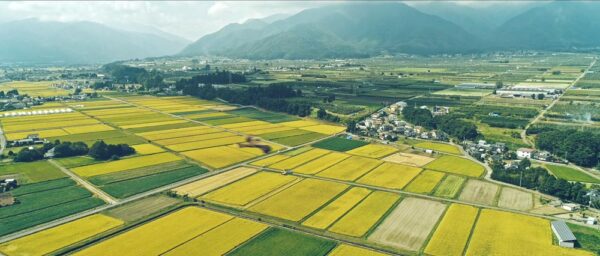
As times drew in the early Showa era, dams were built to develop power sources, and large irrigation canals were also drawn. The structural improvement project began around 1965 and field improvements were carried out, and with the 20-30 R rice fields being rectangularly maintained, it became possible to mow large machines.
"Our ancestors have made considerable efforts to pull water, which is essential for rice cultivation. Thanks to this, the area is now rich in water, and the fields are well maintained, making it a very easy environment to grow rice," says Kurashina.
Through the tireless efforts of these people, Azumino has transformed from a barren land to a rice-like region.
Nagano "Kaze Sayaka" prefecture's original rice
Koyanagi Farm Arai Yasuhiro
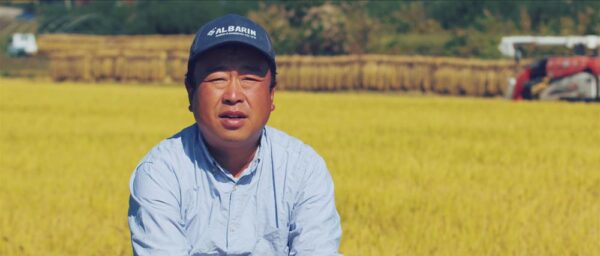
Koyanagi Farm Arai Yasuhiro
There are now more than 900 brands of rice urchin brown rice in Japan, and the number of rice continues to increase year by year. Nagano The prefecture is thriving "Koshihikari" and the planting area accounts for about 70% of the total. In recent years, the lack of labor during the rice harvesting period has become a problem, and there has also been concern about the impact of global warming. It is resistant to heat, and can be adjusted to the harvest time from Koshihikari rice, Nagano The variety was registered in 2013 after receiving calls for a variety that could reveal the characteristics of the prefecture. Nagano This is Kaze Sayaka, an original prefecture rice.
"Kaze Sayaka has an impressive aroma, the sweetness and flavor of the rice, and it has a good throat feel. Koshihikari is delicious to eat as is, but Kaze Sayakari is a rice that will enhance the side dishes when eaten with side dishes. It goes well with dashi, and goes well with Japanese-style meals such as stewed dishes and ochazuke."
To talk about the charm of Kokaze Sayaka,Nakano CityArai Yasuhiro from Koyanagi Farm, which grows a wide variety of rice, including Koshihikari, Mochihikari, sake rice, Yamae-niki, and Miyama-niki, in 180 rice fields. In 2012, he was also selected as a present rice for the Imperial Family Niiname-sai, and was inspired by the words that the Emperor gave to the purpose of "From now on, please do your best to develop agriculture in the region." Nagano It seems that it has strengthened its prefecture-like ambition to cultivate rice. Therefore, Nagano It is said that he has a strong attachment to the prefecture-born "Kaze Sayaka" cultivation.
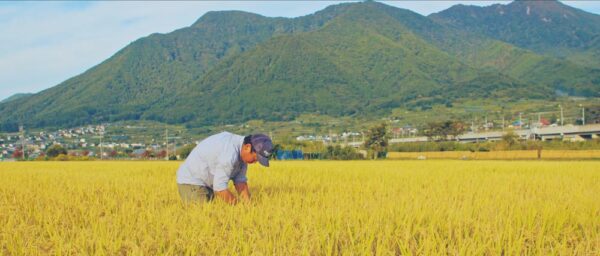
It seems that the growth method varies depending on the variety, and Arai cultivates Koshihikari rice on land with high water retention, while "Kaze Sayaka" is grown according to the characteristics of the variety and soil, such as cultivating it on land with good drainage. The land where wind is grown is a fan-shaped land from the Segawa River at night. The windy creek is grown on a land suitable for fruit cultivation, called sand and gravel layers, where stones transported from the mountains are deposited.
"Kaze Sayaka is a high-yield variety that absorbs fertilizer thoroughly. For this reason, we have adjusted it to avoid over-fertilizing it to create a refreshing taste that is unique to wind-season. The water is not in the Chikuma River system, which is rich in nutrients, but in the evening Segawa River, which is close to the upstream. The characteristic of this area, which has many stones and is easily flowing, is actually suitable for cultivating wind-season cultivation."
In addition, one variety is cultivated on multiple plants, checking the growth status, and comparing them to find the land that suits the variety.
"It has both land and water, and can be achieved by enjoying the rice. I would like to continue to face rice cultivation while thinking about the variety that suits the land and how to grow it," says Arai.
Rice with their own unique characteristics is grown in each land. Nagano prefecture. Rich soil and water, Nagano In addition to the unique climate of the prefecture, the wisdom and tireless efforts of our ancestors are now being made. Nagano This has led to the prefecture's rice farming.
This article is information as of September 2022.
Please note that the products we carry may have changed.















